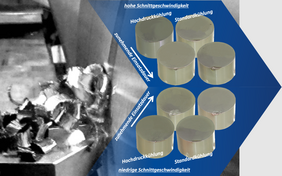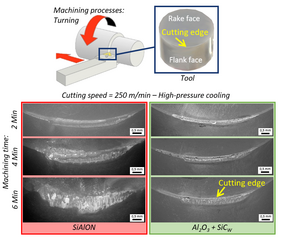During machining processes such as the turning of nickel-based alloys in the aerospace industry, tools are subjected to high loads. Nickel-based alloys have a high hardness. As a result, tungsten carbide-cobalt hardmetal tools only have limited process parameters when machining these alloys.
There is a risk of early, unpredictable tool damage that requires an environmentally and cost-unfavorable tool change. Tool damage in production leads to economic disadvantages of several 100,000 euros per company every year. Moreover, the high demand for critical raw materials such as tungsten and cobalt for tool manufacture must be taken into account.
Ceramics for production increases in the field of Nickel-based alloys
Ceramics consist to a large extent of silicon and aluminum, which are the second and third most common elements in the earth's crust, after oxygen, with 25% and 8% respectively. Materials Center Leoben (MCL) and Montanuniversität Leoben investigated two ceramic tool materials: (1) silicon-aluminum oxide nitride (SiAlON) and (2) aluminum oxide reinforced with thin silicon carbide crystal fibers (Al2O3+SiCW). Both are technical ceramics that are remarkable for their high temperature, wear and chemical stability. The material properties and the development of damage on the cutting edges were analyzed under different cooling conditions and cutting speeds.
The results show that Al2O3+SiCW exhibits far less breakouts, material adhesion and wear compared to SiAlON. Thus, a better tool life and workpiece surface quality was achieved with Al2O3+SiCW than with SiAlON.
Impact and effects
Replacing hardmetal tools with purely ceramic tools increases productivity and extends tool life in the machining of components made from nickel-based alloys. Due to the higher cutting speed (+20%), a cost reduction of 15% per component can be achieved. In addition, the use of purely ceramic tools can reduce system downtimes caused by tool changes. In addition, the need for critical raw materials, such as tungsten and cobalt, and the amount of environmentally harmful cooling lubricants can be reduced.
-
Project coordination (Story)
Dr. Kathrin Maier
Senior Scientist Hard Metals
Materials Center Leoben Forschung GmbH (MCL)
Roseggerstrasse 12, AT 8700 Leoben
Email: kathrin.maier(at)mcl.at
IC-MPPE / COMET-Zentrum
Materials Center Leoben Forschung GmbH
Roseggerstrasse 12
8700 Leoben
T +43 (0) 3842 45922-0
mclburo@mcl.at
www.mcl.at
Project partners
• Ceratizit Austria GmbH, Austria
• Montanuniversität Leoben - Chair of Structural and Functional Ceramics, Austria




















